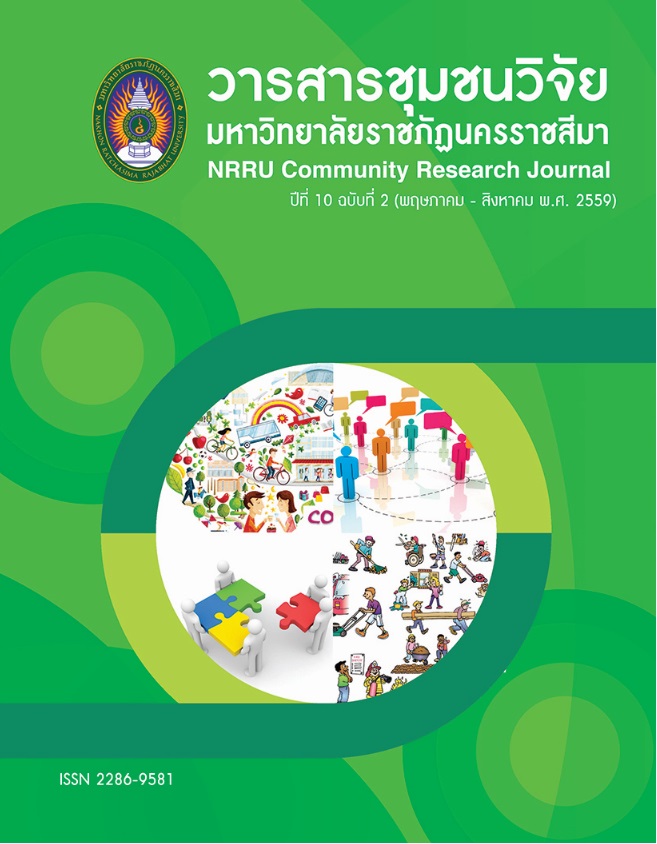ปัจจัยด้านการบริหารจัดการที่ส่งผลต่อประสิทธิผล ของการนำเทคโนโลยีสารสนเทศมาใช้ในการบริหารจัดการ ของสำนักงานแรงงานจังหวัดในภาคตะวันออกเฉียงเหนือ
Keywords:
ประสิทธิผล, การนำเทคโนโลยีสารสนเทศมาใช้, การบริหารจัดการ, สำนักงานแรงงานจังหวัด, Effectiveness, Implementing Information Technology, Management, Provincial Labour OfficeAbstract
การวิจัยนี้มีวัตถุประสงค์เพื่อศึกษาระดับประสิทธิผล เปรียบเทียบประสิทธิผล ศึกษาปัจจัยด้านการบริหารจัดการที่ส่งผล ต่อประสิทธิผล ศึกษาด้านจุดแข็ง จุดอ่อน โอกาส และภัยคุกคาม รวมทั้งศึกษาเสนอแนะเชิงกลยุทธ์ต่อการนำเทคโนโลยี สารสนเทศมาใช้ในการบริหารจัดการของสำนักงานแรงงานจังหวัดในภาคตะวันออกเฉียงเหนือ กลุ่มตัวอย่างเป็นบุคลากร จำนวน 130 คน คำนวณขนาดกลุ่มตัวอย่างโดยใช้สูตรทาโร่ ยามาเน่ ที่ระดับความเชื่อมั่น 95 % และใช้วิธีการสุ่มตัวอย่างแบบชั้นภูมิ ตามสัดส่วน พิจารณาเลือกกลุ่มตัวอย่างโดยใช้วิธีการสุ่มตัวอย่างแบบบังเอิญ เครื่องมือที่ใช้ในการวิจัย ได้แก่ แบบสอบถาม ทำการวัดค่าความเชื่อมั่นของแบบสอบถามทั้งชุด จำนวน 60 ข้อ ได้เท่ากับ .96 สถิติที่ใช้ในการวิเคราะห์ข้อมูล ได้แก่ การแจกแจงค่าความถี่ ค่าร้อยละ ค่าเฉลี่ย ค่าส่วนเบี่ยงเบนมาตรฐาน การทดสอบค่าที การวิเคราะห์ความแปรปรวนทางเดียว และการวิเคราะห์การถดถอยเชิงพหุ ในส่วนของการวิเคราะห์ข้อมูลเชิงคุณภาพ ใช้การวิเคราะห์ SWOT และ TOWS Matrix
ผลการวิจัย พบว่า
1. ประสิทธิผลของการนำเทคโนโลยีสารสนเทศมาใช้ในการบริหารจัดการของสำนักงานแรงงานจังหวัดในภาค ตะวันออกเฉียงเหนืออยู่ในระดับมาก
2. ผลการเปรียบเทียบประสิทธิผลของการนำเทคโนโลยีสารสนเทศมาใช้จำแนกตามอายุ ระดับการศึกษา ตำแหน่งงาน ฝ่ายที่สังกัด ความถี่ในการใช้เทคโนโลยีสารสนเทศ และการฝึกอบรมการใช้งานเทคโนโลยีสารสนเทศไม่มีความแตกต่างกัน ส่วนที่จำแนกตามเพศ และสถานะมีความแตกต่างกัน อย่างมีนัยสำคัญทางสถิติที่ระดับ .05
3. ปัจจัยที่ส่งผลต่อประสิทธิผลของการนำเทคโนโลยีสารสนเทศมาใช้คือ ปัจจัยด้านความรู้ ทักษะ ความสามารถ อย่างมีนัยสำคัญทางสถิติที่ .05
4. จุดแข็งคือ บุคลากรสามารถนำความรู้ทางด้านเทคโนโลยีสารสนเทศไปประยุกต์ใช้ได้ทั้งการดำเนินชีวิตประจำวัน และการทำงานในอนาคต จุดอ่อนคือ บุคลากรขาดทักษะในด้านการเขียนโปรแกรม โอกาสคือ เทคโนโลยีสารสนเทศกำลังเป็น ที่นิยมสามารถนำไปประยุกต์ใช้ได้ทั้งการดำเนินชีวิตประจำวันและการทำงาน อุปสรรคคือ อุปกรณ์ทางด้านเทคโนโลยีมีจำนวน ไม่พอ จึงไม่เอื้ออำนวยต่อการทำงานให้ประสบผลสำเร็จ
5. กลยุทธ์ในการนำเทคโนโลยีสารสนเทศมาใช้คือ เพิ่มคุณภาพทางเทคโนโลยีสารสนเทศเพื่อใช้งานในอนาคต และเพิ่ม มาตรการควบคุมความปลอดภัยเกี่ยวกับการใช้เทคโนโลยีสารสนเทศภายในหน่วยงาน
ADMINISTRATIVE FACTORS AFFECTING THE EFFECTIVENESS OF THE INFORMATION TECHNOLOGY IMPLEMENTATION IN THE MANAGEMENT OF PROVINCAIL LABOUR OFFICES IN THE NORTHEAST
The purposes of this research were to; study the effectiveness’s level, compare the effectiveness’s level, study administrative factors, study the strength, the weakness, the opportunity, and the threat, and strategically recommend for improvement of the information technology implementation in the management of Provincial Labour Offices in the Northeast. The samples were 130 officials, selected by using proportion stratified random sampling. Samples were calculated by Taro Yamane’s formula at the confident level at 95% and the sampling random was used for evaluating the effectiveness’s level. The researcher analysed and selected the research population. The instruments used in the research were questionnaires wich evaluated the coefficient of reliability. Statistical tools employed were percentage, mean, standard deviation, t-test, One way ANOVA, multiple regression analysis, and SWOT analysis and TOWS Matrix to analyze qualitative data.
The research findings were as follow;
1. The effectiveness of the information technology implementation in the management of Provincial Labour Offices in the Northeast was at a high level.
2. The effectiveness of the information technology implementation which classified by ages, education, position, division, frequency of technology using, and technology using training was not different, but classified by sex and status was different at .05 level of significance.
3. Administrative factors affected the effectiveness of the information technology implementation was skill with .05 level of statistical significance.
4. The strength was officials could bring the knowledge of information technology applied to both daily life and work in the future, the weakness was lack of computer programming skills, the opportunity was Information technology was becoming more popular and applied to daily life and work, and the threat was equipment of technology was not enough that was not conducive to the successful work.
5. The strategic recommendations for improvement of the information technology implementation included: the organization should increase information technology quality for the future use and focus on security controls on using of information technology within the organization.





